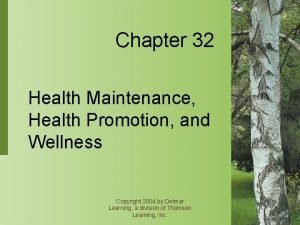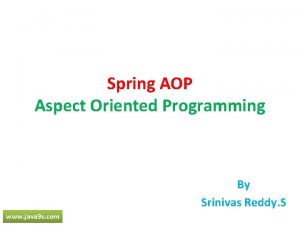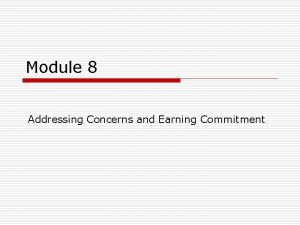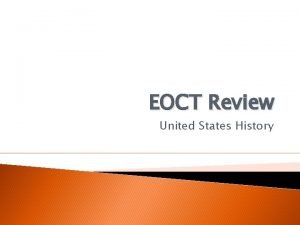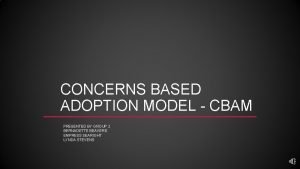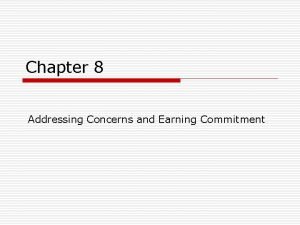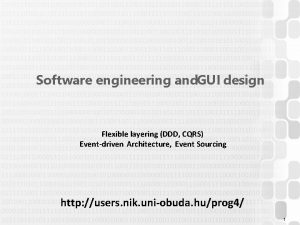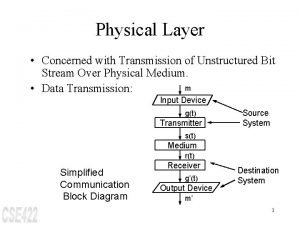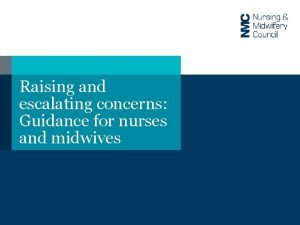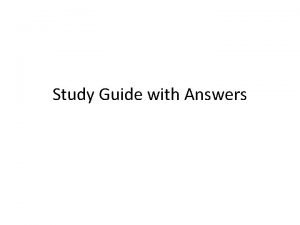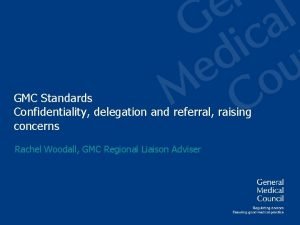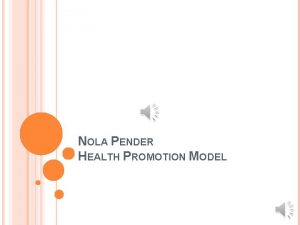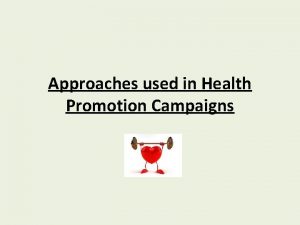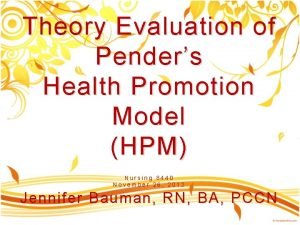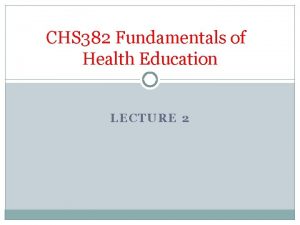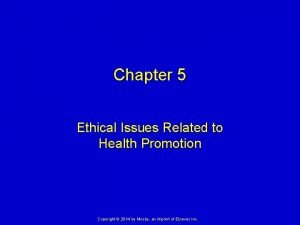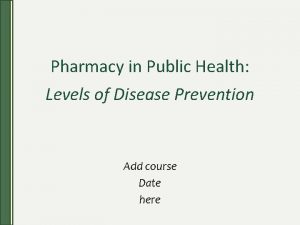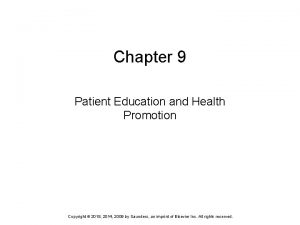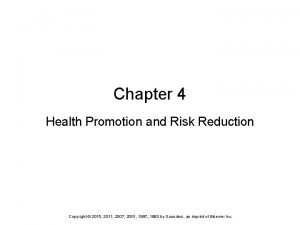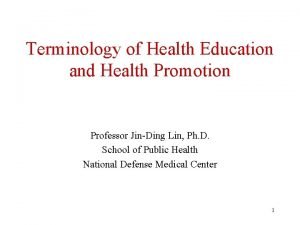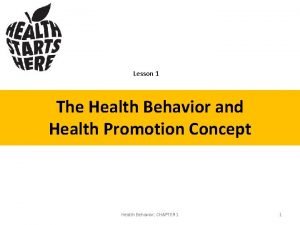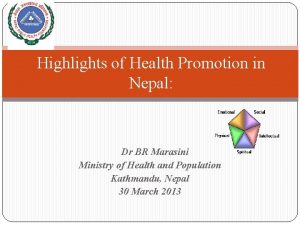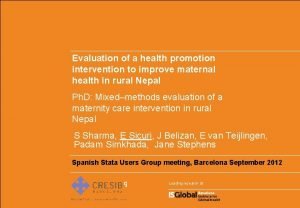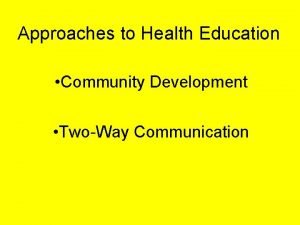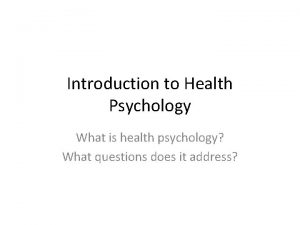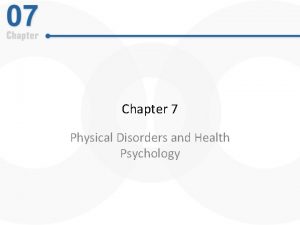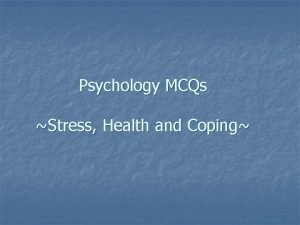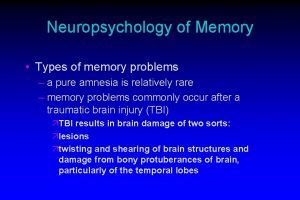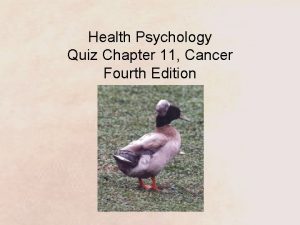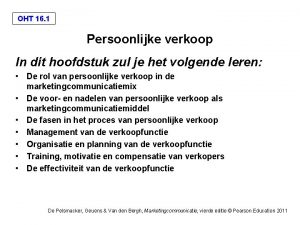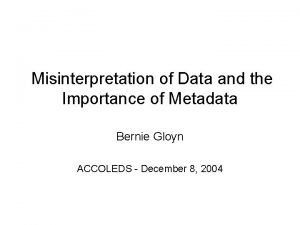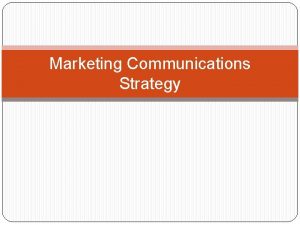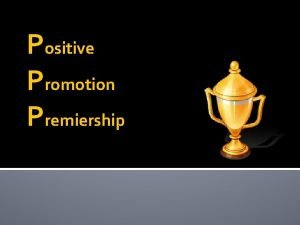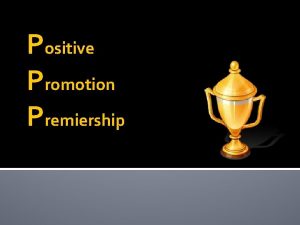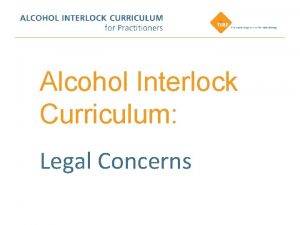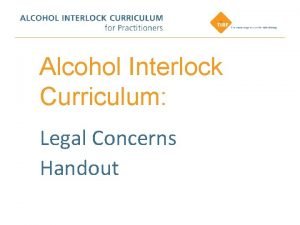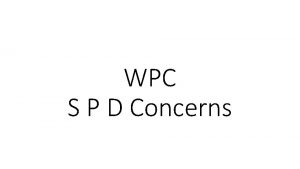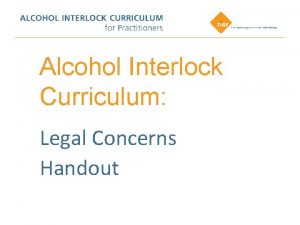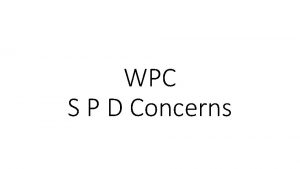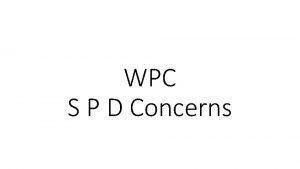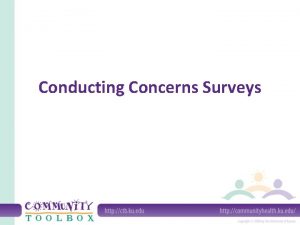Health Promotion Health Psychology Concerns of health promotion








































































































- Slides: 104

Health Promotion Health Psychology

Concerns of health promotion (Ewles and Simnett, 1992) o Health education programmes to raise awareness of health risk and to encourage behaviour change o Primary health education to prevent ill health developing (e. g. diet, hygiene, social skills, etc)

Concerns of health promotion (Ewles and Simnett, 1992) o Preventive health services e. g. family planning, immunisation and well person clinics o Community based work local communities identify health problems and address them o Healthy public policies housing, employment, transport, etc

Concerns of health promotion (Ewles and Simnett, 1992) o Environmental health issues making the physical environment safer e. g. tackling pollution. o Economic and regulatory activities e. g. trying to get the government to raise tax on tobacco, etc

l The Ottawa Charter for Health Promotion (WHO 1986) identified the following features that it believed were necessary for good health: l · Peace l · Shelter l · Education l · Food l · Income l · A stable ecosystem l · Sustained resources l · Social justice l · Equity

Models 1. The medical model 2. The behaviour change model 3. The educational model 4. The empowerment model 5. The social change model


Medical model l Prevention l Primary before illness starts l One of the famous stories of early health promotion concerns the Broad Street pump in Soho, London. In 1854, Dr. John Snow plotted cases of cholera on a map of London and noticed that they clustered around a water pump on Broad Street.

Medical model l At that time, water in London was provided by a number of private companies, and Snow discovered that the death rate from cholera was much higher for people using water from two of these companies (71 deaths per 10, 000 people) than the others (only 5 deaths per 10, 000 people). Snow’s observation of the pattern of cases around Soho allowed him to carry out a natural experiment. He disabled the Broad Street pump by removing the handle (hi tech or what? ) and the cholera epidemic subsided in the area. From this, Snow was able to show that cholera was carried in water (Donaldson and Donaldson, 2000. )

Primary Prevention l Genetic counselling. Future parents are able to get important information about the possibility of their future child being born with a genetic disorder. Factors such as the age of the parents and the results of biological tests may be taken into account. Tests can be made on the unborn foetus, but such techniques are hazardous to the foetus.

Primary Prevention l Immunisation of children would also be a way of preventing illnesses. l The analysis of questionnaires about health behaviour could also be useful in helping people to adopt a healthy lifestyle.

Secondary prevention l Secondary prevention concerns identifying an illness fairly early, before there has been much damage. It used to be thought that an annual check up would identify imminent illnesses, but it is now thought that between 6 and 10 specific tests can suffice. The American cancer society (1992) recommended that women should have mammograms (breast x ray), but recently, in Britain, this practice has been called into question. Colon inspections are recommended for those over 40.

Mammogram

Mammogram

Breast Self Examination

Cancer and Breast Self. Examination l BSE effective in early detection of Breast Cancer. Pitts (1991) <30% British women perform BSE l Meyerowitz and Chaiken (1987) the effectiveness of Gain and Loss messages. Gain message worked best. Therefore campaigns should use a positive message.

Cancer and Breast Self. Examination l The BSE instructions are rather complicated. a simpler procedure called `Breast awareness' has been introduced. As the procedure is simpler, women are more confident in being able to carry it out. The procedure produces less false positives. This is when the person falsely identifies a problem, or believes they may be developing breast cancer, when they are not (Murray and Mc. Millan, 1993).

Colon Cancer

Testicular Cancer l From the time of puberty onwards you should do a simple quick check of yourself regularly. This will help you to know what is normal for you (everyone is different) and you will be able to detect any changes early on.

Testicular Cancer l. A good place to do this is in, or immediately after a bath or a shower, when the muscle in the scrotal sac is more relaxed. l You could ask your partner to help. l Hold your scrotum in the palm of your hands, so that you can use the fingers and thumb on both hands to examine your testicles.

Testicular Cancer l Note the size and weight of the testicles. It is common to have one slightly larger, or which hangs lower than the other, but any noticeable increase in size or weight may mean something is wrong. l Gently feel each testicle individually

Testicular Cancer l You should feel a soft tube at the top and back of the testicle. This is the epididymis which carries and stores sperm. It may feel slightly tender. Don’t confuse it with an abnormal lump. l You should be able to feel the firm, smooth tube of the spermatic cord which runs up from the epididymis.

Testicular Cancer l Feel the testicle itself. It should be smooth with no lumps or swellings. It is unusual to develop cancer in both testicles at the same time, so if you are wondering whether a testicle is feeling normal or not, you can compare it with the other.

Tertiary Prevention containing or slowing down the damage

Barriers to Primary Prevention l • we have only limited knowledge about what behaviours are threatening to our health, for example, it is only in the last forty years that we have discovered the very harmful effects of tobacco smoking

Barriers to Primary Prevention l • we have a lack of knowledge about how we develop health threatening behaviours, for example, some behaviours to do with diet or exercise develop over many years from our childhood l • a number of health behaviours are learnt in the home, for example, the children of smokers are more likely to smoke than the children of non smokers

Barriers to Primary Prevention l • at the time that health threatening behaviours develop, people often have little immediate incentive to practice health enhancing behaviours, for example the effects of smoking are felt in middle to later life rather than when people start smoking l • people are often unrealistically optimistic about their health

3 main reasons why primary prevention has been ignored l Traditional structure of medicine l Difficulty of getting people to practice healthy behaviours l Difficulty in applying methods of attitude and behavioural change to health

THREE APPROACHES TO HEALTH PROMOTION l Behaviour change approach l Objective: to bring about changes in individual behaviour through changes in individuals' cognitions. l Process: provision of information about health risks and hazards.

THREE APPROACHES TO HEALTH PROMOTION l Behaviour change approach l Aim: . to increase individuals' knowledge about the causes of health and illness. . l Assumption: humans are rational decision makers whose cognitions inform their actions.

THREE APPROACHES TO HEALTH PROMOTION l Self-empowerment approach l Objective: to empower individuals to make healthy choices. l Process: participatory learning techniques. l Aim: to increase control over one's physical, social and internal environments. l Assumption: power is a universal resource which can be mobilised by every individual.

THREE APPROACHES TO HEALTH PROMOTION l Collective action approach l Objective: to improve health by addressing socio economic and environ mental causes of ill health. . l Process: individuals organize and act collectively in order to change their physical and social environments.

THREE APPROACHES TO HEALTH PROMOTION l Collective action approach l Aim: to modify social, economic and physical structures which generate ill. health. l Assumption: communities of individuals share interests which allows them to act collectively.

BEHAVIOUR CHANGE APPROACH l Consider how the issue of smoking is dealt with by the Health Belief Model (HBM; Becker, 1974). Smokers deciding whether or not to give up smoking would be expected to consider: l how susceptible they are to lung cancer and other smoking related conditions; l how serious these conditions are; l the extent and value of the benefits of giving up smoking; l the potential negative consequences of giving up smoking.

BEHAVIOUR CHANGE APPROACH l In addition, the HBM acknowledges the role of cues to action, internal (e. g. a symptom such as a smoker's cough) and external (e. g. information, advice or meeting someone with lung cancer), as well as health motivation, and the importance of health to the individual.

BEHAVIOUR CHANGE APPROACH l The HBM has been applied to a wide range of health behaviours including the uptake of flu vaccinations, breast self examination, anti hypertensive regimes, mothers' adherence to regimens for their children and risk factor behaviours (e. g. seatbelt use, attendance at health check ups, diets, etc. ). Overall, the 'HBM is marginally successful in predicting health behaviours. Each key variable of the HBM tends to be significantly correlated with the behaviour under study.

BEHAVIOUR CHANGE APPROACH l This suggests that the variables identified by the HBM are relevant ingredients and contribute to the process which generates health behaviour. However, our ability to accurately predict health behaviour on the basis of the HBM is severely limited.

BEHAVIOUR CHANGE APPROACH l The theory of reasoned action (TRA; Fishbein and Ajzen, 1975) and its revised version, theory of planned behaviour (TPB; Ajzen, 1985) propose that behaviour is informed by attitudes towards the behaviour as well as subjective norms about the behaviour, that is what significant others think one should do. These variables (and in the case of the TPB an additional variable: perceived control over the behaviour) combine to generate an intention to behave in a particular way, which is then used to predict actual behaviour.

BEHAVIOUR CHANGE APPROACH l Attitudes and subjective norms are based upon beliefs held by the individual. So, for example, a woman's belief that birth control pills are a potential health risk and her belief that her friends and relatives would not approve of her taking such a risk are thought to generate a negative attitude towards taking birth control pills, as well as social pressure not to take them; thus giving rise to the intention to refrain from the use of birth control pills and, hopefully, to consider other forms of contraception.

BEHAVIOUR CHANGE APPROACH l The TRA and TPB have been used to predict numerous health behaviours, including smoking, alcohol consumption, contraceptive use/safer sex, health screening attendance, exercise, food choice and breast/testicle self examination. Overall, the evidence suggests that TRA and TPB do contribute to our understanding of the antecedents of health relevant behaviours.

BEHAVIOUR CHANGE APPROACH l However, it is important to bear in mind that the TRA and TPB do not actually predict behaviour but only the intention to behave. Unfortunately, correlations between intention to behave and actual behaviour are not perfect. They tend to range between 0. 45 and 0. 62.

A study using the TRA (Rise, 1992) l Rise (1992) used the TRA as a theoretical framework in order to study 'condom behaviour' defined as 'a decision based upon consideration of the expected consequences of using or not using condoms'. A postal questionnaire about condom use was completed by 1, 172 Norwegian adolescents aged 17 to 19 years and all non virgins.

A study using the TRA (Rise, 1992) l The following variables were measured: – The intention to use condoms at the next intercourse – – (behavioural intention). . Beliefs about condom use, e. g. 'condoms protect me against sexually transmitted diseases' (behavioural beliefs). Evaluation of behavioural beliefs and outcomes, e. g. 'How much do you fear STD? ' (values). Significant others' evaluation of the respondent's condom use (normative beliefs). , Importance of significant others' evaluation (motivation to comply). Previous/habitual condom use (prior behaviour).

A study using the TRA (Rise, 1992) l Rise (1992) observed that past behaviour was by far the strongest predictor of intention to use condoms at the next intercourse. Next came subjective norm followed by attitude. All relationships were statistically significant. Behavioural beliefs related to pleasure and sensation (e. g. 'Condom use reduces my physical pleasure') discriminated best between intenders and non intenders whereas traditional risk appraisal beliefs (e. g. 'Condom use protects me against STD') did not discriminate. Among normative beliefs, sexual partners' expectations had the best discriminatory power. '.

CRITICISMS OF SCMS l l l 1 SCMs are only concerned with cognitively mediated behaviours. 2 SCMs do not take into account the direct effect of impulse and/or emotion. 3 SCMs assume that the same variables inform different health behaviours. 4 SCMs assume that the same variables are relevant for diverse groups of people. 5 SCMs focus exclusively upon mental representations of the social world and do not take into account the direct effects of material, physical and social factors. 6 SCMs do not address the issue of joint decision making.

Criticisms of the behaviour change approach l. is unable to target the major socio economic causes of ill health; l. operates top down; l. assumes that there is a direct link between knowledge, attitudes and behaviour; l. assumes homogeneity among the receivers of health promotion messages.

SELF-EMPOWERMENT APPROACH l The goal of this approach to health promotion is to empower individual people to make healthy choices. Self empowerment can be defined as the process by which groups and individuals increase their control over their physical, social and internal environments. In order to facilitate self empowerment, participatory learning techniques allow people to examine their own values and beliefs and explore the extent to which factors such as past socialization as well as social location affect the choices they make (Homans and Aggleton, 1988).

SELF-EMPOWERMENT APPROACH l Group work, problem solving techniques, client centred counselling, assertiveness training and social skills training as well as educational drama are forms of participatory learning. The self empowerment paradigm, with its emphasis upon self awareness and skills, resonates with what Stroebe and Stroebe (1995) refer to as the 'therapy model' of health promotion which deploys a wide range of psychological techniques such as cognitive restructuring, skill training and self conditioning in order to help individuals act upon their intentions to adopt health behaviours.

SELF-EMPOWERMENT TECHNIQUES l Participatory l Group learning work l Problem solving l Client centred counselling l Assertiveness training l Social skills training l Educational drama

Self-empowerment l Self empowerment is particularly popular within health education for young people. For example, peer pressure has been identified as a powerful obstacle to the adoption of healthy practices by young people. Here, self empowerment techniques encourage young people to make independent decisions by developing their psychological resources to resist peer pressure, the so called 'say no' technique. This has been attempted through assertiveness training, social skills training, inoculation to persuasive appeals and life skills training, with limited success (Hopkins, 1994).

Self-empowerment l. A range of HIV preventive interventions for young people are informed by a self empowerment rationale (Abraham and Sheeran, 1994).

Self-empowerment l These include rehearsal of communication and interaction sequences which might be involved in condom purchase or sexual negotiation, questioning and challenging sexual scripts which do not allow space for negotiation of contraceptive use, peer education programmes, as' well as group based cognitive behavioural programmes aiming to identify and then modify personal obstacles to HIV prevention.

Self-empowerment l All of these involve reflexive self appraisal as well as the acquisition of new skills. Abraham and Sheeran (1994) argue that such empowerment based interventions can be effective in increasing perceived selfefficacy which has been shown to be a powerful predictor of intention formation and behaviour (e. g. Bandura, 1992).

Self-empowerment l Thus, Abraham and Sheeran (1994) move beyond the more simplistic behaviour change/information giving approach, to manipulate social change model variables through empowerment techniques. Indeed, these authors also acknowledge the importance of power relations and cultural resources which require change at a community level.

An example of an empowermentbased intervention (Lugo, 1996) l The Resource Sisters Program was an empowerment education project for pregnant women in orange County, Florida (Lugo, 1996). The programme focused on areas which had high rates of low birth weight babies, infant mortality, substance exposed new borns and poverty.

An example of an empowermentbased intervention (Lugo, 1996) l It was implemented in an inner city area, a rural section of the county and a quasi suburban area. The programme was designed (a) to employ and enhance the natural skills of women from the community (peer counsellors) to assist other women and foster collective problem solving; (b) provide outreach and case management through home visits; (c) to develop ongoing peer support groups.

An example of an empowermentbased intervention (Lugo, 1996) l Local women were recruited and trained to become peer educators. The intensive three week group training covered empowerment, resources, needs assessment, case management, women's issues, problem posing, prenatal health, labour and delivery and group facilitation.

An example of an empowermentbased intervention (Lugo, 1996) l Trained peer counsellors visited women in their homes who had been identified as high risk (medically, demographically and/or psychosocially) by the state screening programme. These visits provided an opportunity for individual needs assessment and case management, as well as to encourage the women to attend support group meetings.

An example of an empowermentbased intervention (Lugo, 1996) l The evaluation showed that around 20% of women who had been contacted came to at least one support group meeting. Participation was greatest in' the rural community and was lowest among white women. Over 40% of women who had come to one group meeting returned several times. Thus, obtaining a high level of initial participation seemed to be a challenge.

An example of an empowermentbased intervention (Lugo, 1996) l Issues raised and discussed by the women in the groups commonly included personal violence, stress, relationships, parenting, physiological and emotional changes during pregnancy and concerns with basic survival (food, housing, etc. ). The groups were a forum for discussion of individual choices, decision making and self care, as well as collective problem solving.

An example of an empowermentbased intervention (Lugo, 1996) l The groups developed social cohesion which was demonstrated by contact among participants outside the group meetings. Peer counsellors reported an increased sense of empowerment and options since working with the programme. However, after the first year of the programme there were no significant differences between clients' and non clients' low birth weight rates.

An example of an empowermentbased intervention (Lugo, 1996) l Lugo (1996) draws attention to the fact that the programme was externally imposed, as an alternative model for providing state mandated case management for at risk pregnant women.

Criticisms of the selfempowerment approach l it is assumed that rational choices are healthy choices; l strong reliance upon simulation; l inadequate concept of power.

COLLECTIVE ACTION APPROACH l The aim of collective action is to improve health by addressing socio economic and environmental causes of ill health within the community. Thus, this approach recognises the close relationship between individual health and its social and material contexts, which consequently become the target for change. Individuals. act collectively in order to change their environment rather than themselves.

COLLECTIVE ACTION APPROACH l For example, in one German city, the community group identified weight as a health problem in the community and decided to approach butchers in the city with the request to develop a new low fat sausage (Conner, 1994).

COLLECTIVE ACTION APPROACH l In addition, the Healthy Cities Project aims to develop new ideas in public health. For example, research into the impact of poor housing on health (Hunt, 1993) found that levels of mould in the air had a direct and independent effect upon the health of children living in the dwellings. This study's findings were used to campaign for changes in housing conditions.

Collective action as community empowerment l Outreach health education with intravenous drug using communities at risk of HIV infection provides a good example of the collective action approach. Community outreach strategies aim to achieve subcultural change among target constituencies.

Collective action as community empowerment l Outreach involves the use of key members of the target community as indigenous workers who communicate a series of complementary risk reduction messages to other members of the community. In addition, such strategies can be incorporated within existing self help initiatives which aim to achieve wider social and political change.

Collective action as community empowerment l For example, the Junkiebonden, a federation of Dutch self help groups, aims to initiate community change through campaigning for the modification of local and national drug policy.

Collective action as community empowerment l The Junkiebonden was involved in the setting up of the first syringe exchange in the Netherlands in 1984. Since then, it has distributed education and prevention materials to drug users and sex workers through outreach techniques. The Junkiebonden was set up from within the drug using community and is run pre dominantly by current drug users.

Collective action as community empowerment l Evaluation of the needle exchange programme in Amsterdam has been positive. Since the establishment of the needle exchange network, the number of injectors has remained constant whilst the number of people joining treatment schemes has increased. The rate of HIV infections decreased.

Problems associated with the collective action approach l vulnerable to lack of funding and to official oppositions; l danger of creeping professionalisation; l problematic concept of 'community'.

THE 'IDEOLOGY OF HEALTH PROMOTION' l Health promotion is concerned with strategies for promoting health. It is assumed that (a) good health is a universally shared objective; (b) there is agreement on what being healthy means; (c) there is a scientific consensus about which behaviours facilitate good health.

THE 'IDEOLOGY OF HEALTH PROMOTION' l However, there have been criticisms of this contemporary 'ideology of health promotion'. Evans (1988) was concerned that such an ideology can begin to drive health promotion interventions which instead ought to be informed by scientific evidence (both biomedical and psychosocial).

THE 'IDEOLOGY OF HEALTH PROMOTION' l Evans drew attention to programmes directed at lifestyle changes which are not unequivocally justified by biomedical research evidence, such as the recommendation to reduce cholesterol levels in the blood to prevent heart disease.

THE 'IDEOLOGY OF HEALTH PROMOTION' l Evans worried that 'by increasingly promoting presumably non risky behaviours, we may be contributing to a type of mass hypochondriasis resulting in an increasingly diminished freedom in human lifestyle and quality of life’. This, he suggested, can result in an unhealthy obsession with exercise, an inability to enjoy a meal, as well as a reduction in spontaneity of lifestyle.

THE 'IDEOLOGY OF HEALTH PROMOTION' l Lupton (1995) developed a critique of the discourse of risk prevalent in contemporary health promotion. She proposed that 'risk, in contemporary societies, has come to replace the old fashioned (and in modern secular societies now largely discredited) notion of sin'.

THE 'IDEOLOGY OF HEALTH PROMOTION' l This is achieved through the practice of health risk appraisals and screening programmes. Lupton likens these practices to religious confessions where sins are confessed, judgement is passed and penance is expected. Lupton points out that risk discourse attributes ill health to personal characteristics such as lack of will power, laziness or moral weakness.

THE 'IDEOLOGY OF HEALTH PROMOTION' l In this way those 'at risk'. become 'risk takers' who are responsible for their own ill health as well as its effects upon others and society as a whole.

THE 'IDEOLOGY OF HEALTH PROMOTION' l Lupton argues that risk discourse can have detrimental consequences for those positioned within it: being labelled at risk can become a self fulfilling prophecy since people may feel reluctant to seek medical advice for fear of being reprimanded.

THE 'IDEOLOGY OF HEALTH PROMOTION' l Also, it can give rise to fatalism, as well as anxiety, uncertainty and fear, as, for example, for women 'at risk' of breast cancer who can experience their 'at risk' status as a half way house between health and illness (Gifford, 1986, cited in Lupton, 1995).

Three points about health behaviour: l Behaviours can change over time l Health habits are not strongly interdependent l Health behaviours are not governed by a single set of attitudes; you may not smoke because it irritates you, and you might diet because you wish to be attractive.

There are three types of health behaviour – Health behaviour refers to activity that a well person would engage in, in order to prevent illness – Illness behaviour concerns the behaviour someone would engage in, in order to find out what is wrong with him or her and to procure a remedy. – Sick role behaviour concerns the behaviour a patient engages in, in order to overcome their illness.

Cues in the Environment l Many bad health practices are triggered by cues in the environment, with which the behaviour has been associated with in the past. For example, the sight of an open packet of cigarettes might be enough to trigger the action of lighting up, despite a bad cold. (Hunt et al 1979).

The impact of the family upon children's health behaviour. l Children pick up the good health behaviours (e. g. diet, exercise, not smoking, etc) of other family members. Modelling and reinforcement play a part in this process. (Baranowski & Nader, 1985).

The impact of the family upon children's health behaviour. l Sick role behaviour could be determined in the family. A study of female college students accessed whether they had been encouraged during adolescence to adopt the sick role for menstruation or had seen their mothers get upset over menstruation. These women reported more menstrual symptoms, disability and attended clinic more often in adulthood compared with other students (Whitehead et al, 1986).

Yale Model of Communication

Yale Model of Communication l The Yale Model of Communication holds the following specific implications for designing health promotion campaigns: – 1. It is important that the source of the information is perceived as credible by the audience. – 2. When the audience is positive towards the communicator and the message it is best to use a one sided argument.

Yale Model of Communication – 3. • A low level of fear arousal is necessary in order to trigger perceived threat, but too much fear will cause high levels of tension, leading to avoidance (e. g. Janis and Feshbach 1953). – 4. The message should be short, clear and direct. – 5. The message should be colourful and vivid rather than full of technical terms and statistics.

Yale Model of Communication – 6. • If a message is complex, or the audience not very well informed, then conclusions need to be explicitly stated. Otherwise, it is better to let the audience reach its own conclusions. – 7. • Certain individuals (for example, with low self esteem) are easier to persuade than others, but they are as likely to be influenced by negative health messages (from advertising and the media) as by health promotion messages.

Yale Model of Communication – 8. • If possible, it is best to involve the audience in active participation in the communication process as the effects of the message will last longer.

Fear Appeals l Early study (Lashley & Watson, 1921) – Study of health education films, warning of the risk of VD to First World War soldiers from prostitutes. Films were graphic and had story lines.

Fear Appeals l Findings – Storylines are too risky as often the story is remembered but not the health message – Must be frank (not flippant) about sex. – Fear arousing effects do not have desired effect. l Baggaley (1991) media campaigns on AIDS make the above mistakes.

Fear Appeals l Janis and Feshbach (1953) – Minimal fear appeal 36% conformity (evidence based on self report). Strong fear appeal 8% conformity Illustrated lectures (15 mins) on dangers of tooth decay and need for oral hygiene.

Criticism l Fear appeals could lead to the person putting up a resistance to the message. The use of an Ego defence mechanism could be an explanation. l Effects are short lived (Leventhal and Hirschman, 1982) l. A message needs to tell of appropriate behaviour as well (Leventhal, 1970). l Fear appeals may induce learned helplessness.

Fear Appeal and Self-Efficacy l The technique of combining the fear message with a self efficacy message is a common theme in current research, and it appears that the most effective combination is to have a high fear message with a high self efficacy message (Witte and Allen, 2000). What commonly appears in health education messages, however, is a high fear message with little or no self efficacy message.

Fear Appeal and Self-Efficacy l. A review of messages designed to encourage breast self examination (BSE) found that the leaflets had an unbalanced proportion of threat to efficacy information. BSE is a technique that women can use to screen themselves for breast cancer, and the alternative screening technique is to use the hi tech medical procedure called mammography.

Fear Appeal and Self-Efficacy l Interestingly, in the leaflets analysed in the study, the arguments in favour of screening by mammography were very strong, suggesting that there was an underlying aim to encourage the women to seek out medical procedures rather than take control of their own health (Kline and Mattson, 2000).

Learning theory and health behaviour. l Reinforcement – If the health behaviour is rewarding then the behaviour is likely to continue. For example, a child might be given a penny for brushing her teeth. An example of a negative reinforcement would be a tablet alleviating a headache.

Learning theory and health behaviour. l Extinction – The taking away of a reward might cause the health behaviour to cease. For example, if the child is no longer given a penny for brushing her teeth, then she might stop; however smiling should prove to be an effective substitute for the money.

Learning theory and health behaviour. l Punishment – If good health behaviour is producing unpleasant side effects then the behaviour is likely to cease. l Modelling – Observing others Bandura (1965).

Coronary heart disease and excessive drinking l Drinking associated with social and cultural norms (Bennett and Murphy, 1994) l In Glasgow, campaign based on safe number of units, replaced with one that concentrated on social costs of drinking too much (Leather, 1981)

Accidents l Chip pan fire campaign (Compe 1989) – The campaign produced a 25% reduction in chip pan fires in some areas. 12% reduction overall. Campaigns are most effective if they contain information about what to do rather than what to think or what to be scared of.

The end
 Health concerns
Health concerns Health concerns
Health concerns Health concerns
Health concerns Dwrfism
Dwrfism Comfort food psychology
Comfort food psychology Health psychology definition ap psychology
Health psychology definition ap psychology Differences between health education and health promotion
Differences between health education and health promotion Health promotion world health organization
Health promotion world health organization University of central florida health care administration
University of central florida health care administration Cross-cutting concerns
Cross-cutting concerns Software design separation of concerns
Software design separation of concerns The network layer concerns with
The network layer concerns with Addressing concerns and earning commitment
Addressing concerns and earning commitment What are the concerns of the constitutions?
What are the concerns of the constitutions? Product +concerns
Product +concerns Concerns based adoption model
Concerns based adoption model Southwest airlines code of ethics
Southwest airlines code of ethics A traditional method of earning commitment is the
A traditional method of earning commitment is the Joys and concerns
Joys and concerns Joys and concerns prayer
Joys and concerns prayer Ddd cross cutting concerns
Ddd cross cutting concerns Matzas
Matzas Chapter 6 process selection and facility layout
Chapter 6 process selection and facility layout Pietro molla
Pietro molla Closeness rating examples
Closeness rating examples The physical layer concerns with
The physical layer concerns with Identify concerns
Identify concerns Taiga features
Taiga features When a choice concerns matters of personal value or taste
When a choice concerns matters of personal value or taste Joys and concerns images
Joys and concerns images Vocopher
Vocopher Escalating concerns
Escalating concerns It concerns many sociologists
It concerns many sociologists Design concerns
Design concerns Clear light of day as a partition novel
Clear light of day as a partition novel What are banquo's concerns about the witches prophecy
What are banquo's concerns about the witches prophecy Dr smith
Dr smith Macbeth act 1 study guide
Macbeth act 1 study guide Where has macduff gone and why
Where has macduff gone and why Macmillan concerns checklist
Macmillan concerns checklist Positive psychology ap psychology definition
Positive psychology ap psychology definition Psychology chapter 13 social psychology
Psychology chapter 13 social psychology Fundamental attribution error ap psychology
Fundamental attribution error ap psychology Introspection method in psychology
Introspection method in psychology Social psychology is the scientific study of
Social psychology is the scientific study of Pengertian promkes adalah
Pengertian promkes adalah Pender metaparadigm
Pender metaparadigm Method of health promotion
Method of health promotion Health promotion approach
Health promotion approach Pender nursing theory
Pender nursing theory Professional nursing practice concepts and perspectives
Professional nursing practice concepts and perspectives Nola pender health promotion model articles
Nola pender health promotion model articles Health promotion emblem
Health promotion emblem Five ethics in health promotion
Five ethics in health promotion Health promotion and levels of disease prevention
Health promotion and levels of disease prevention Patient readiness to learn
Patient readiness to learn Health promotion and levels of disease prevention
Health promotion and levels of disease prevention Health promotion program in malaysia
Health promotion program in malaysia Caplan and holland model of health promotion
Caplan and holland model of health promotion Who health promotion glossary
Who health promotion glossary Ottawa charter of health promotion
Ottawa charter of health promotion Health promotion definition
Health promotion definition Health promotion strategies
Health promotion strategies Health promotion cycle
Health promotion cycle Chicago partnership for health promotion
Chicago partnership for health promotion Health promotion initiatives pdhpe
Health promotion initiatives pdhpe Communication and community development
Communication and community development Aim of health psychology
Aim of health psychology Introduction to health psychology
Introduction to health psychology Physical disorders and health psychology
Physical disorders and health psychology Psychology, mental health and distress
Psychology, mental health and distress Stress management mcqs
Stress management mcqs Health psychology associates
Health psychology associates Enrich health and psychology
Enrich health and psychology Health psychology quiz
Health psychology quiz Promotion request windchill
Promotion request windchill Trade promotion coordinating committee
Trade promotion coordinating committee Time bound promotion for doctors in tamilnadu
Time bound promotion for doctors in tamilnadu Primary demand stimulation
Primary demand stimulation Structure of the advertising industry
Structure of the advertising industry Starbucks marketing
Starbucks marketing Setting the total promotion budget and mix
Setting the total promotion budget and mix Type of sales promotion
Type of sales promotion Trade sale promotion
Trade sale promotion Difference between advertising and sales promotion
Difference between advertising and sales promotion Selogram
Selogram Trade promotion management phases
Trade promotion management phases Fiscal incentives for industrial promotion (revised)-2013
Fiscal incentives for industrial promotion (revised)-2013 Promotion opportunity analysis
Promotion opportunity analysis Promotional displays
Promotional displays Joint promotion examples
Joint promotion examples Promotion from assistant to associate professor
Promotion from assistant to associate professor Product vs institutional promotion
Product vs institutional promotion What is direct marketing in promotion mix
What is direct marketing in promotion mix To remind is the promotional objective
To remind is the promotional objective Nadelen sales promotion
Nadelen sales promotion Insesis
Insesis Mvm promotion
Mvm promotion Promotion survey questions
Promotion survey questions Marketing direct et de promotion des ventes
Marketing direct et de promotion des ventes Above the line
Above the line Promotions mix
Promotions mix Sales promotional activities
Sales promotional activities Sales promotion vehicles
Sales promotion vehicles Communications mix
Communications mix







